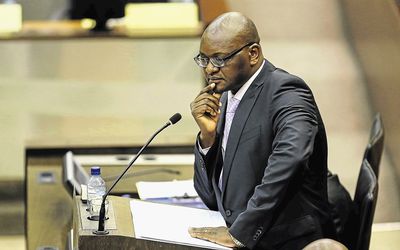WHEN President Jacob Zuma delivered the state of the nation address ahead of the budget, he warned of tough times ahead. He also implored the provinces’ premiers and mayors to follow his austerity cue. This he did fully aware that the various premiers’ state of the province addresses would follow the finance minister’s budget speech.
The expectation was that the premiers would amplify the president’s state of the nation address and give it a more provincial and regional slant. SA being a vast country, the effect of the economic slump has had a varied and uneven effect on different regions and economic sectors. This implies policy measures and instruments should be tailored for each region and provincial situation.
Aspects that have stuck in the minds of many people from the state of the nation address and budget are the projected economic growth rate of less than 1%, the 25% unemployment rate, persistent deep inequality and rising poverty. But the growth and unemployment rates are average figures.
Some parts of the country are actually in deep recession, with growth rates as low as -6% and unemployment rates of 70% or more.
In those parts of SA, poverty is grinding and the level of deprivation alarming.
The president and finance minister have responded to the crises by giving broad direction and parameters they hope will steer SA out of the economic morass. Accordingly, while Zuma’s broad policy direction was radical by South African standards, the finance minister gave substance to the president’s commitment by presenting a fiscal package whose point of departure is that we are not only in a low-growth environment, but that we need to deal with drought, low confidence and a subdued global economy.
The centrepiece of Finance Minister Pravin Gordhan’s fiscal package was fiscal consolidation — (read austerity measures) the key elements being the imposition of an expenditure ceiling, the reduction of the budget deficit, efforts to increase the tax base and tax rates, modest spending on economic and social infrastructure, and maintaining the usual safety nets.
Perhaps the most important announcement Zuma made was the commitment to review some state-owned institutions. Gordhan was even more blunt: SA does not need three airlines.
The current interest rate level and inflation target completes the liberal macroeconomic package — fiscal restraint, low inflation, reduced public expenditure, competitive exchange rates, privatisation and a reduced public service.
But what does all this mean for province and regions? What are the implications of the economic situation looked at through a regional and provincial lens? More specifically, do the rating agencies care only about the macro picture, or are they concerned about the regional and provincial picture?
A brief overview of the various state of the province addresses reveals that most made a great effort to take their cue from the state of the nation address by beating the same drum of optimism and infrastructure plans.
The major weakness is that the state of the province addresses did not give us the benefit of the logic and analysis that formed the basis of what otherwise were very eloquent and well-delivered speeches. Gauteng, and to some extent the Eastern Cape, were exceptions. Gauteng benefits from possibly being the most analysed regional economy and has been sliced and diced in a variety of forms.
Premier David Makhura’s reference to the corridor-development strategy, the construction of new cities and township revitalisation as key focus areas will have resonated for even the most casual observer of the Gauteng economy. Similarly, the Eastern Cape address was comprehensive and provided a meaningful frame within which to understand the interventions proposed by the premier.
In some provinces, North West for instance, the targeted 6% growth rate appears highly optimistic when the rest of the country is expected to grow by less than 1%. This growth rate becomes even more suspect when one analyses the interventions that are proposed to achieve that growth target.
In all other provinces, the state of the province addresses were fairly well articulated, save for the lack of rigour in the analyses of the regional economies. The exception is in one specific province, where you could have mistaken the state of the province address for the political report of the governing party. This kind of partisan orientation, while it may endear the premier to his political superiors, does little to promote investor confidence and social solidarity.
What Zuma and Gordhan presented was really a "growth package" intended to restore confidence in the business community and placate the rating agencies. Regions and provinces must provide a "development package" focusing on interventions, instruments and a set of measures aimed at enhancing regional competitiveness and economic development by giving expression and precision to the macroeconomic and fiscal measure outlined in the state of the nation address and the budget.
More importantly, there should be coherence at all levels and in all spheres of government to ensure that none of these actions undermine the overall objective. Such policy measures should cover the supply and demand side of the equation.
The policy response needs to be anchored by a well-considered regional development policy. International experience indicates that certain regions in the country could be a source of competitiveness and prosperity even when the country overall is battling low growth rates. KwaZulu-Natal, for instance, if properly positioned, has the potential to grow tourism as a region far more competitively, in the same way as Bali has in Indonesia.
Northern Cape, North West and Limpopo, where many of SA’s mineral resources are located, need special attention. Their growth rates are likely to be depressed in part because of sluggish commodity prices. This is unlikely to improve in the medium term, even with the help of generous stimuli.
Regional development policy should enable us to assess the true extent of the territorial effect of the various national policy interventions. Not long ago, the liberalisation of trade arrangements resulted in the devastation the textile industry, which was the economic mainstay of the Western Cape in terms of employment for the working class and livelihoods for the poor.
Well-articulated regional development policy may help SA stem a territorial competition that accelerates the race to the bottom and creates economic and resource inefficiencies. The proliferation of industrial development zones in most parts of the country when there is a dearth of technical skills may require review. Similarly, while infrastructure investment is undoubtedly essential to increase productivity, it may be that in certain areas, rehabilitation and maintenance is what is needed most urgently, particularly where economic activity has declined.
An intriguing aspect of virtually all provincial addresses was their emphasis on intervention in agriculture. With the drought afflicting some parts of the country, the credibility and sustainability of this intervention becomes doubtful, certainly in some provinces. In times of austerity, industrial development policy will enable choices to be made, informed by a clear understanding of the capacity and potential of each region.
• Mahlangu, a former chairperson of the Municipal Demarcation Board, now chairs the Gaffney Group

Gauteng premier David Makhura has tasked officials with tackling the concerns of communities in the province in a bid for the ANC to capture votes in local elections next year. Picture: THE TIMES
WHEN President Jacob Zuma delivered the state of the nation address ahead of the budget, he warned of tough times ahead. He also implored the provinces’ premiers and mayors to follow his austerity cue. This he did fully aware that the various premiers’ state of the province addresses would follow the finance minister’s budget speech.
The expectation was that the premiers would amplify the president’s state of the nation address and give it a more provincial and regional slant. SA being a vast country, the effect of the economic slump has had a varied and uneven effect on different regions and economic sectors. This implies policy measures and instruments should be tailored for each region and provincial situation.
Aspects that have stuck in the minds of many people from the state of the nation address and budget are the projected economic growth rate of less than 1%, the 25% unemployment rate, persistent deep inequality and rising poverty. But the growth and unemployment rates are average figures.
Some parts of the country are actually in deep recession, with growth rates as low as -6% and unemployment rates of 70% or more.
In those parts of SA, poverty is grinding and the level of deprivation alarming.
The president and finance minister have responded to the crises by giving broad direction and parameters they hope will steer SA out of the economic morass. Accordingly, while Zuma’s broad policy direction was radical by South African standards, the finance minister gave substance to the president’s commitment by presenting a fiscal package whose point of departure is that we are not only in a low-growth environment, but that we need to deal with drought, low confidence and a subdued global economy.
The centrepiece of Finance Minister Pravin Gordhan’s fiscal package was fiscal consolidation — (read austerity measures) the key elements being the imposition of an expenditure ceiling, the reduction of the budget deficit, efforts to increase the tax base and tax rates, modest spending on economic and social infrastructure, and maintaining the usual safety nets.
Perhaps the most important announcement Zuma made was the commitment to review some state-owned institutions. Gordhan was even more blunt: SA does not need three airlines.
The current interest rate level and inflation target completes the liberal macroeconomic package — fiscal restraint, low inflation, reduced public expenditure, competitive exchange rates, privatisation and a reduced public service.
But what does all this mean for province and regions? What are the implications of the economic situation looked at through a regional and provincial lens? More specifically, do the rating agencies care only about the macro picture, or are they concerned about the regional and provincial picture?
A brief overview of the various state of the province addresses reveals that most made a great effort to take their cue from the state of the nation address by beating the same drum of optimism and infrastructure plans.
The major weakness is that the state of the province addresses did not give us the benefit of the logic and analysis that formed the basis of what otherwise were very eloquent and well-delivered speeches. Gauteng, and to some extent the Eastern Cape, were exceptions. Gauteng benefits from possibly being the most analysed regional economy and has been sliced and diced in a variety of forms.
Premier David Makhura’s reference to the corridor-development strategy, the construction of new cities and township revitalisation as key focus areas will have resonated for even the most casual observer of the Gauteng economy. Similarly, the Eastern Cape address was comprehensive and provided a meaningful frame within which to understand the interventions proposed by the premier.
In some provinces, North West for instance, the targeted 6% growth rate appears highly optimistic when the rest of the country is expected to grow by less than 1%. This growth rate becomes even more suspect when one analyses the interventions that are proposed to achieve that growth target.
In all other provinces, the state of the province addresses were fairly well articulated, save for the lack of rigour in the analyses of the regional economies. The exception is in one specific province, where you could have mistaken the state of the province address for the political report of the governing party. This kind of partisan orientation, while it may endear the premier to his political superiors, does little to promote investor confidence and social solidarity.
What Zuma and Gordhan presented was really a "growth package" intended to restore confidence in the business community and placate the rating agencies. Regions and provinces must provide a "development package" focusing on interventions, instruments and a set of measures aimed at enhancing regional competitiveness and economic development by giving expression and precision to the macroeconomic and fiscal measure outlined in the state of the nation address and the budget.
More importantly, there should be coherence at all levels and in all spheres of government to ensure that none of these actions undermine the overall objective. Such policy measures should cover the supply and demand side of the equation.
The policy response needs to be anchored by a well-considered regional development policy. International experience indicates that certain regions in the country could be a source of competitiveness and prosperity even when the country overall is battling low growth rates. KwaZulu-Natal, for instance, if properly positioned, has the potential to grow tourism as a region far more competitively, in the same way as Bali has in Indonesia.
Northern Cape, North West and Limpopo, where many of SA’s mineral resources are located, need special attention. Their growth rates are likely to be depressed in part because of sluggish commodity prices. This is unlikely to improve in the medium term, even with the help of generous stimuli.
Regional development policy should enable us to assess the true extent of the territorial effect of the various national policy interventions. Not long ago, the liberalisation of trade arrangements resulted in the devastation the textile industry, which was the economic mainstay of the Western Cape in terms of employment for the working class and livelihoods for the poor.
Well-articulated regional development policy may help SA stem a territorial competition that accelerates the race to the bottom and creates economic and resource inefficiencies. The proliferation of industrial development zones in most parts of the country when there is a dearth of technical skills may require review. Similarly, while infrastructure investment is undoubtedly essential to increase productivity, it may be that in certain areas, rehabilitation and maintenance is what is needed most urgently, particularly where economic activity has declined.
An intriguing aspect of virtually all provincial addresses was their emphasis on intervention in agriculture. With the drought afflicting some parts of the country, the credibility and sustainability of this intervention becomes doubtful, certainly in some provinces. In times of austerity, industrial development policy will enable choices to be made, informed by a clear understanding of the capacity and potential of each region.
• Mahlangu, a former chairperson of the Municipal Demarcation Board, now chairs the Gaffney Group
























Change: 1.19%
Change: 1.36%
Change: 2.19%
Change: 1.49%
Change: -0.77%
Data supplied by Profile Data
Change: -0.19%
Change: 0.69%
Change: 1.19%
Change: 0.00%
Change: 0.44%
Data supplied by Profile Data
Change: 0.62%
Change: 0.61%
Change: 0.23%
Change: 0.52%
Change: 0.12%
Data supplied by Profile Data
Change: -0.21%
Change: -1.22%
Change: -0.69%
Change: -0.51%
Change: 0.07%
Data supplied by Profile Data